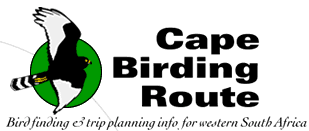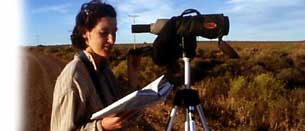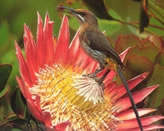|
Information Service
We hope to promote ecotourism in
Cape Town and beyond into Africa. We would be glad to answer
any quiries you might have on birding, natural history or
travel in the Western Cape along the Western Cape Birding
Routes, in southern Africa or in the Indian Ocean Islands.
Please feel free to email info@capebirdingroute.org.
Birding
Seasons
The best time to go birding in the
Western Cape is springtime. This is because the majority of
the region receives its rain in winter, and the animals and
plants must use the small window of opportunity to breed while
temperatures are sufficiently high and moisture is still in
good supply. Birding picks up significantly towards the end
of August, and the very best birding months are September
to December. However, the weather at this time of year is
unpredictable, as the winter rains often linger. Spring is
also the time to witness the West Coast and Namaqualand flower
displays, with the peak flower season varying from late August
to late September (p.99).
Good birding continues into the summer, although things slowly
become less active when water supplies dwindle as this hot,
dry season progresses. In contrast, Bushmanland, the Nama
Karoo and the Kalahari experience summer thundershowers, resuscitating
the grasses and revitalizing the birdlife. Autumn is thus
the best birding season in these regions, although spring
is also very productive. As autumn progresses into winter,
pelagic birding off the Cape becomes increasingly exciting
(see the monthly table on p.35), but the persistent, rainy
cold fronts that buffet the coastal area in midwinter can
make birding impossible for days at a time.
Itineraries
Foreign birders visiting the western
portion of South Africa as part of a longer tour around the
country will need a very bare minimum of five days based in
Cape Town. Those interested in exploring Namaqualand, Bushmanland
or the Kalahari will clearly need more time. Good loops through
these areas would ideally need at least three days each, plus
additional driving time if travelling to the Kalahari from
Cape Town.
Those in Cape Town on business and with only a few hours to
spare can still see a good selection of Cape specials at sites
close to the city. The Kirstenbosch National Botanical Garden
(p.15) is undoubtedly the best such locality: it is a mere
15 minutes’ drive from the city centre. Furthermore,
it is easily accessible by public transport (consult Cape
Town Tourism, p.136). Other good localities within 30 minutes
of the city are the Strandfontein sewage works (p.26), Kommetjie
(p.21), Boulders Beach (p.24) and even the Atlantic shoreline
right outside the city centre (p.31) – within walking
distance of the Waterfront. For those with three or more days
to spend in Cape Town, we would recommend a day each on the
Cape Peninsula, the Tanqua Karoo, and either the West Coast
or the Overberg region. A very desirable addition would be
a day out at sea (Seabirding).
While an ideal visit to western South Africa would encompass
most if not all of the routes we describe in this book, this
is clearly not practical for those with limited time. Here
(below) we propose two itineraries for the serious birder,
aiming to maximise coverage of endemic species. We can amend
these itineraries based on the desired focus and length of
your tour. Please contact
us.
One-week itinerary
Day 1: Cape Peninsula: Kirstenbosch,
Cape of Good Hope, Boulders
Day 2: Seabirding boat trip
Day 3: West Coast
Day 4: Cape Peninsula in morning: Constantia Greenbelt. Then
to Ceres via Paarl and Bain’s Kloof.
Day 5: Ceres – Tanqua Karoo – Cape Town
Day 6: Overberg: Sir Lowry’s Pass, Overberg farmland
loops to De Hoop, Swellendam
Day 7: Overberg: Grootvadersbosch, return to Cape Town
Two-week itinerary
Day 1: Kirstenbosch, Cape of Good Hope, Boulders (Cape Peninsula)
Day 2: Seabirding boat trip
Day 3: Sir Lowry’s Pass – De Hoop – Swellendam
(Overberg and South Coast)
Day 4: Grootvadersbosch – Cape Town (Overberg and South
Coast)
Day 5: Cape Town – Darling and West Coast National Park
Day 6: West Coast – Kransvlei Poort– Brandvlei (West
Coast and Bushmanland)
Day 7: Brandvlei – Kenhardt (Bushmanland)
Day 8: Kenhardt – Kalahari Gemsbok National Park (Bushmanland
and Kalahari)
Day 9: Kalahari Gemsbok National Park
Day 10: Kalahari Gemsbok National Park
Day 11: Kalahari Gemsbok National Park – Pofadder (Kalahari
and Bushmanland)
Day 12: Pofadder – Port Nolloth – Springbok (Namaqualand)
Day 13: Springbok – Kamieskroon
Day 14: Kamieskroon – Cape Town
If you wish to visit the Garden Route forests,
it is equally possible to continue on to them from Swellendam.
One can then link to the central Bushmanland
region via Swartberg Pass and the Karoo National Park, rather
than from the West Coast as above, and instead visit the West
Coast in a day trip from Cape Town.
Health,
Safety and Travel
Please consult local tourist information offices (see p.136)
for further information on the topics discussed below. None
of the sites covered in this book are unusually dangerous,
although we do urge visitors to be
cautious and alert, particularly in Cape Town and on the Cape
Peninsula, as birders’ inevitable need to carry conspicuously
valuable equipment makes them potential targets for casual
muggings. Sites that are perhaps best not visited alone are
Strandfontein sewage works (p.26) and Sir Lowry’s Pass
(p.60), although years of birding activities at these sites
have yet to result in any incidents. Petty theft is common;
never leave bags or birding equipment unattended on car seats.
Visitors may be relieved to hear that there is no malaria
in the region covered by this book, although it has been recorded
previously in the Kalahari Gemsbok National Park (p.107; enquire
before visiting). Should you be lucky enough to see a snake
or scorpion, please be cautious as some species are potentially
dangerous.
Road infrastructure in South Africa is excellent, and none
of the routes recommended in this book require a four-wheel-drive
vehicle. However, there might be potential driving hazards
in rural areas for those unaccustomed to unsurfaced roads.
We refer the reader to pp.77 and 87. If you need to travel
long distances in the Northern Cape, please be sure to carry
a good water supply in case of breakdowns. In the latter respect,
be aware that mobile phone coverage in remoter areas is far
from complete.
A wide range of accommodation is available across most of
the region, especially in the coastal areas; consult tourist
information for further details (p.136). Accommodation in
the national parks and most nature reserves is superb and
great value for money. All small rural towns have service
stations and basic, inexpensive hotels, and many have municipal
campsites. Tap water in towns is invariably potable. Public
transport is limited, often unsafe, and best avoided.
Birding
Etiquette
With the ever-increasing popularity of birding in South Africa,
there is inevitably pressure on certain well-visited sites.
While the roadside often provides excellent birding in rural
areas, please ask permission at the nearest farmhouse if you
would like to enter private land. Playback of bird calls is
a very helpful birding tool, and limited tape playing is unlikely
to have a detrimental effect in most cases. However, we urge
birders to refrain from excessive playback, especially during
the breeding season and at popular sites such as those for
Knysna Warblers on the Cape Peninsula (p.19), and Cinnamon-breasted
Warblers at Katbakkies (p.79).
Information
- Further reading
Lists of recommended
field guides and other references and useful contacts
appear on pp.135 and 136.
Bird Clubs
Local birders are encouraged to join the Cape
Bird Club, currently Africa’s largest bird club,
and one of 20 regional branches of BirdLife
South Africa (see Useful Contacts, p.136). This is a friendly
and informal club; regular club activities include a monthly
evening meeting in Newlands (Cape Town) and numerous monthly
half-day outings and other events. All members receive a quarterly
magazine. The Cape Bird Club and BirdLife South Africa are
committed to the conservation of birds and their habitats.
Internet
birding
The local e-mail list, Cape BirdNet, provides
an active forum of over 400 birders for local observations,
rarity updates, trip reports and local birding events in the
region covered by this book (to join, see "Recent Sightings").
E-mail lists provide the visitor with all sorts of helpful
titbits for trip preparation. You may also wish to join SA
BirdNet, a similar birding forum serving the whole
of southern Africa (to join, contact norman@nu.ac.za).
Recent
Sightings
Click on direct
link to Cape BirdNet postings
The local e-mail list, Cape BirdNet, provides an active
forum of over 400 birders for local observations, rarity updates,
trip reports and local birding events in the region covered
by this book. E-mail lists provide the visitor with all sorts
of helpful titbits for trip preparation and the very latest
sightings from the region.
To join instantaneously, send a blank email to
capebirdnet-subscribe@yahoogroups.com.
To view the up to date emails on the web, browse to: http://groups.yahoo.com/group/capebirdnet/
(when prompted for a password, you will need to "Sign
Up" with Yahoo! and choose your own password).
Reporting
sightings
Please report all sightings of colour-ringed birds, and ring
numbers from dead birds, to SAFRING (see p.136). Birders can
also contribute to other valuable projects run by the Avian
Demography Unit. If you see any species that are either very
rare or not recorded for this region, please contact the local
or national rare bird committees via the Cape Bird Club and
BirdLife South Africa respectively (p.136).
|


